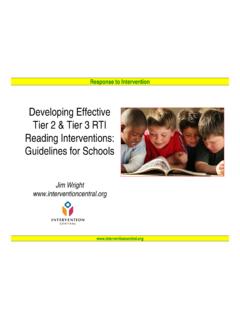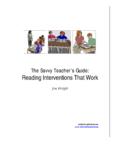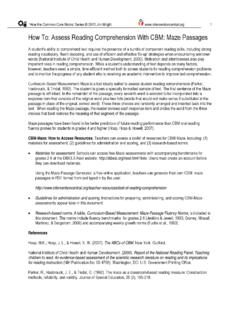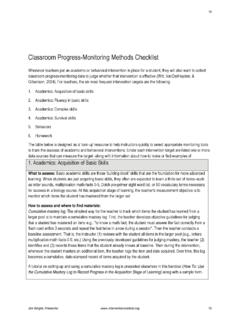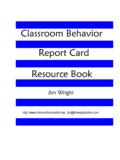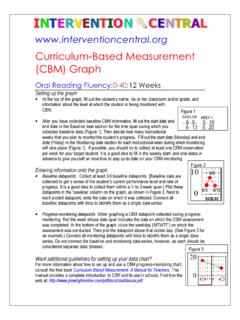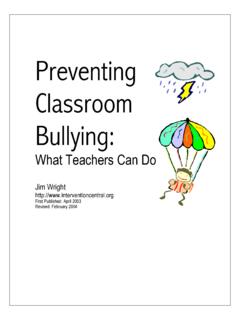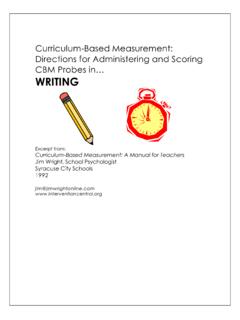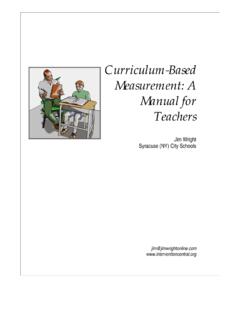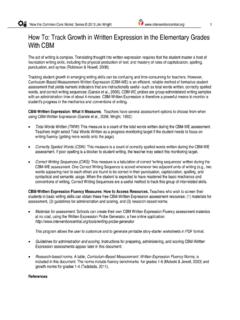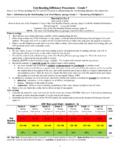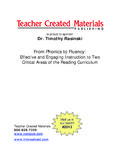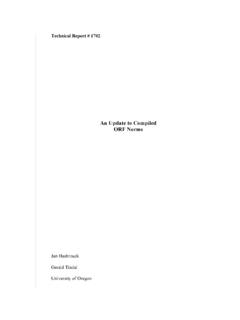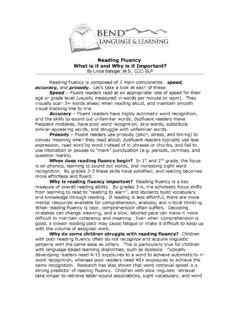Transcription of How To: Assess Reading Speed With CBM: Oral Reading ...
1 How the Common Core Works Series 2013 Jim Wright 1 How To: Assess Reading Speed with CBM: oral Reading fluency Passages A student's accuracy and Speed in Reading aloud is an obvious and readily observable indicator of that student's Reading ability. Reading fluency is an essential component of a student's global Reading skills (National Institute of Child Health and Human Development, 2000). Furthermore, up through grade 3, Reading fluency is arguably the best predictor of future Reading success (Hosp, Hosp, & Howell, 2007). The curriculum-based measure to track student Reading Speed is termed oral Reading fluency (ORF). In CBM-ORF, the student is given a grade-appropriate passage and asked to read aloud for one minute. The examiner marks as incorrect any words that the student misreads or hesitates on for 3 seconds or longer.
2 The passage is then scored for Correctly Read Words (CRW). Although CBM-ORF is simple in format and quick to administer, its results are sensitive to short-term student gains in Reading skills and predictive of long-term Reading success, making this assessment an ideal progress-monitoring tool for classroom use. CBM-ORF: How to Access Resources. Teachers can access a toolkit of resources for CBM-ORF, including: (1) materials for assessment, (2) guidelines for administration and scoring, and (3) research-based norms. Materials for assessment. DIBELS NEXT: Here are 3 sources for free CBM-ORF materials: DIBELS NEXT: Schools can obtain free ORF passages and ORF benchmarks for grades 1-6 from the DIBELS Next website: EasyCBM: The easyCBM website ( ) has collections of CBM-ORF passages (referred to as 'Passage fluency ') for grades 1-8.
3 Teachers can create a free account on this website to access materials and benchmarks. Schools can also make their own CBM oral Reading fluency passages in PDF format based on text typed in by the user using the Reading fluency Passages Generator, a free online application: Guidelines for administration and scoring. I nstructions for preparing, administering, and scoring CBM-ORF assessments appear later in this document: Research-based norms. A table, Curriculum-Based Measurement: oral Reading fluency Norms, is included in this document. The norms include fluency benchmarks for grades 1-8 and accompanying growth norms (Hasbrouck & Tindal, 2005). References Hasbrouck, J., & Tindal, G. (2005). oral Reading fluency : 90 years of measurement. Eugene, OR: Behavioral Research & Teaching/University of Oregon.
4 Retrieved from Hosp, , Hosp, J. L., & Howell, K. W. (2007). The ABCs of CBM. New York: Guilford. National Institute of Child Health and Human Development. (2000). Report of the National Reading Panel. Teaching children to read: An evidence-based assessment of the scientific research literature on Reading and its implications for Reading instruction (NIH Publication No. 00-4769). Washington, DC: Government Printing Office. How the Common Core Works Series 2013 Jim Wright 2 Curriculum-Based Measurement- oral Reading fluency (ORF): Guidelines for Use CBM-ORF: Description CBM-ORF measures a student's Reading fluency by having that student read aloud for 1 minute from a prepared passage. During the student's Reading , the examiner makes note of any Reading errors in the passage.
5 Then the examiner scores the passage by calculating the number of words read correctly. CBM-ORF: Materials The following materials are needed to administer a CBM-ORF passage: Student and examiner copies of a CBM-ORF passage (the process for creating ORF passages is described below) Stopwatch CBM-ORF: Preparation When assessing a student's oral Reading fluency skills, the examiner chooses 3 grade-appropriate passages. For children in the 1st and 2nd grades, each passage should be at least 150 words long, while passages of at least 250 words should be prepared for older students. Passages selected should not contain too much dialog and should avoid an excessive number of foreign words or phrases. In addition, only prose passages should be used in CBM assessments.
6 Poetry and drama should be avoided because they tend to vary considerably and do not represent the kind of text typically encountered by students. For ease of administration, the instructor will want to prepare examiner and student copies of each passage. Ideally, Reading passages should be free of illustrations that may help a child to interpret the content of the text. The examiner copy should have a cumulative word total listed along the right margin of the passage for ease of scoring (see Figure 1). It is strongly recommended that teachers use existing collections of well-constructed, Reading passages organized by grade-level when conducting oral Reading fluency assessments. Here are 3 sources for free CBM-ORF materials: DIBELS NEXT: Schools can obtain free ORF passages and ORF benchmark norms for grades 1-6 from the DIBELS Next website: Summertime!
7 How lovely it was in the country, with 9 the wheat standing yellow, the oats green, and the hay all 20 stacked down in the grassy meadows! And there went the stork 31 on his long red legs, chattering away in Egyptian, for 41 he had learned that language from his mother. The fields and 52 Summertime! How lovely it was in the country, with the wheat standing yellow, the oats green, and the hay all stacked down in the grassy meadows! And there went the stork on his long red legs, chattering away in Egyptian, for he had learned that language from his mother. The fields and Figure 1: Example of CBM oral Reading fluency Probe Examiner Copy Student Copy ---------------------------------------- ---------------------------------------- ---------------------------------------- ---------------------------------------- --------------------------------------- ---------------------------------------- ---------------------------------------- ---------------------------------------- ---------------------------------------- --------------------------------------- How the Common Core Works Series 2013 Jim Wright 3 EasyCBM: The easyCBM website ( ) has collections of CBM-ORF passages (referred to as 'Passage fluency ') for grades 1-8.
8 Teachers can create a free account on this website to access materials and benchmark norms. Schools can also make their own CBM oral Reading fluency passages in PDF format based on text typed in by the user using the Reading fluency Passages Generator, a free online application: CBM-ORF: Directions for Administration (Hosp, Hosp, & Howell, 2007; Wright, 2007) 1. The examiner and the student sit across the table from each other. The examiner hands the student the unnumbered copy of the CBM Reading passage. The examiner takes the numbered copy of the passage, shielding it from the student's view. 2. The examiner says to the student: "When I say, 'begin', start Reading aloud at the top of this page. Read across the page [demonstrate by pointing]. Try to read each word.
9 If you come to a word you don't know, I'll tell it to you. Be sure to do your best Reading . Are there any questions? [Pause] Begin." 3. The examiner starts the stopwatch when the student says the first word. If the student does not say the initial word within 3 seconds, the examiner says the word and starts the stopwatch. 4. As the student reads along in the text, the examiner records any errors by marking a slash (/) through the incorrectly read word. If the student hesitates for 3 seconds on any word, the examiner says the word and marks it as an error. 5. At the end of 1 minute, the examiner says, "Stop" and marks the student's concluding place in the text with a bracket ( ] ). 6. Initial Assessment: If the examiner is assessing the student for the first time, the examiner administers a total of 3 Reading passages during the session using the above procedures and takes the median (middle) score as the best estimate of the student's oral Reading fluency .
10 Progress-Monitoring: If the examiner is monitoring student growth in oral Reading fluency (and has previously collected ORF data), only one Reading passage is given in the session. CBM-ORF: Directions for Practice If the student is not yet familiar with CBM- oral Reading fluency probes, the teacher can administer one or more practice ORF probes (using the administration guidelines above) and provide coaching and feedback as needed until assured that the student fully understands the assessment. CBM-ORF: Scoring Guidelines Reading fluency is calculated by first determining the total words attempted within the timed Reading probe and then deducting from that total the number of incorrectly read words. The following scoring rules will aid the instructor in marking the Reading probe: Words read correctly are scored as correct: Self-corrected words are counted as correct.
